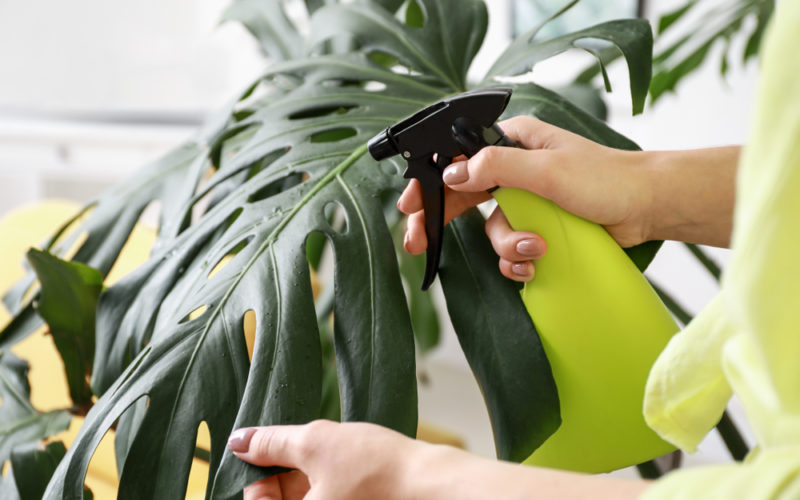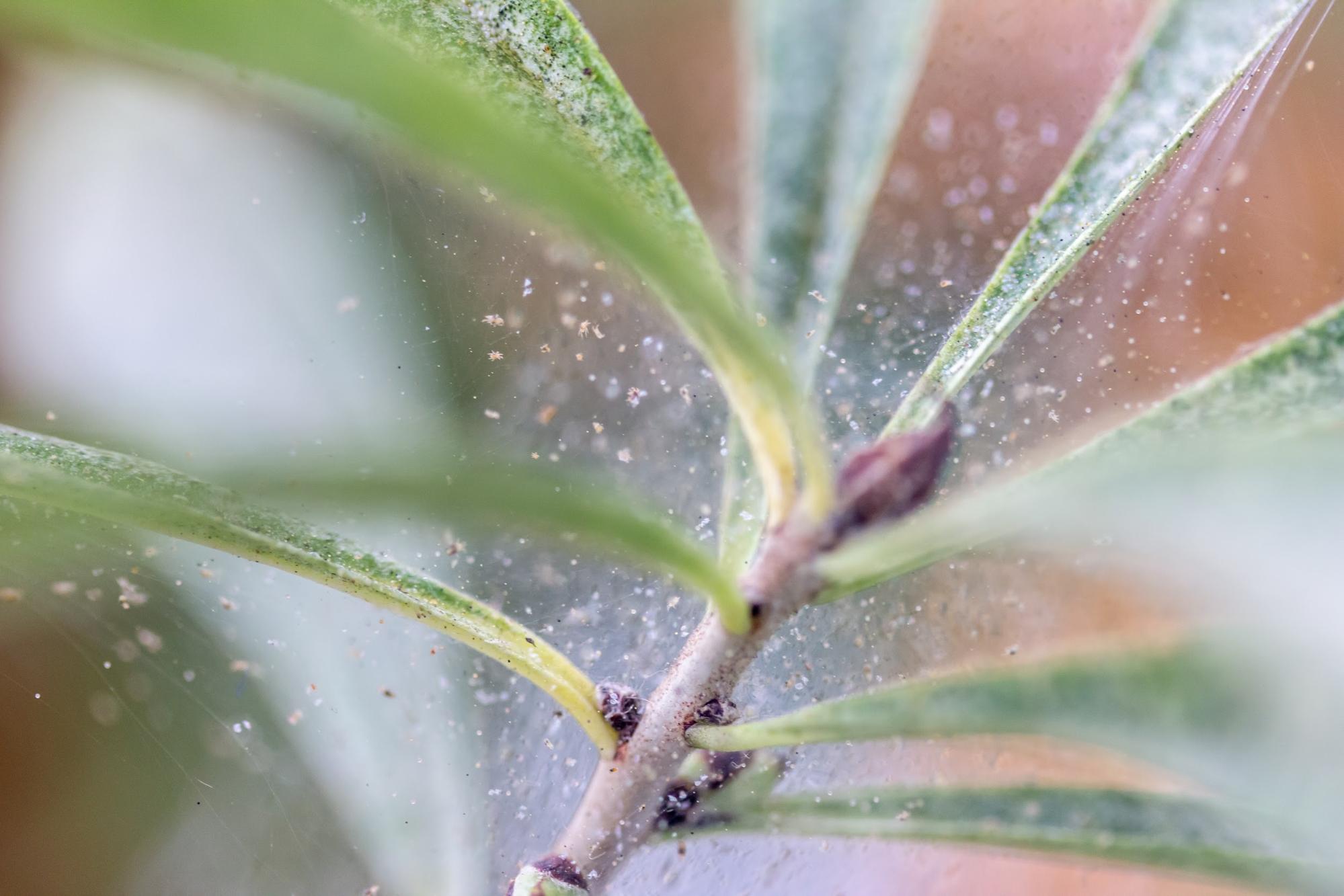How To Get Rid of Bugs on Indoor Plants

Some houseplant owners go years simply watering and fertilizing, without ever having to deal with pests. And then, they bring home one new plant, and suddenly find themselves with a huge infestation of spider mites or scales. If you’re unsure of how to get rid of bugs on indoor plants, we have good news: most types of indoor plant pests can be eradicated without the death of any of your plants!
5 Common Houseplant Pests (And How to Treat Them)
While there are hundreds of pests you may encounter based on your plants, your climate, and your environment, there are five common houseplant pests that you’re most likely to encounter. Use the links below to skip through the article and learn how to get rid of bugs in houseplants.
Aphids
Scales
Spider Mites
Mealybugs
Fungus Gnats
1. How To Get Rid Of Aphids
Aphids are tiny green, yellow, or white bugs that suck on the stems and leaves of your plants and slowly kill them. While they aren’t as common as some other pests, they are incredibly persistent and reproduce rapidly, making them hard to get rid of once they’ve arrived.

Luckily, aphids are soft-bodied and can be killed easily.
Start by rinsing your houseplant thoroughly with a sink sprayer, shower, or hose. This will get rid of the majority of adult aphids present on your plant. Then, spray regularly with insecticidal soap or neem oil. You can also sprinkle systemic granules into the affected planters. The granules will help to kill existing aphids and prevent them from coming back for up to two months.
When you think your aphids are gone, continue spraying and examining your plant regularly for an additional week or two. It’s crucial to kill every last egg, or you’ll be back to square one a few days later.
2. How To Get Rid Of Scales
Scales are small, flat, brown bugs that slowly weaken your houseplants by sucking the sap from their stems and leaves. The adults have hard shells that make them difficult to kill with insecticidal soap or a blast of water.

The best way to treat scale is to treat one generation at a time.
First, remove any dead or damaged branches or stems. Then, carefully scrape off all of the visible adult scales with a fingernail, a brush, or even a blade. Be sure to smash them before disposing of them, so that they don’t return or lay further eggs. Finish up with neem oil or an insecticidal soap to kill eggs and younger scales before they develop their hard shells.
Like with many other types of plant pests, consistency is key, so check each day for new adults to be scraped off.
3. How To Get Rid Of Spider Mites
If you ever see what appear to be cobwebs all over your plants, you unfortunately may have spider mites. Spider mites are extremely tiny insects that suck the sap out of leaves and stems and leave a telltale web behind.

Treating spider mites can truly test your patience.
Start by rinsing or wiping down all leaves to remove the webs and any visible mites. Take extra care to check on the underside of leaves, as mites often start their webs underneath the curling edges of leaves. Then, spray routinely with insecticidal soap or neem oil and wipe or spray the plant down whenever you see new webs.
The key to conquering spider mites is catching the infestation early. While it is possible to save plants that have brittle or yellowing leaves from spider mites, your best chance at success is catching them as soon as their webs develop.
4. How To Get Rid Of Mealybugs
Mealybugs are fluffy, white insects that are closely related to scales. Like scales, they suck on stem joints to weaken them over time. Unfortunately, mealybugs are one of the toughest types of plant pests to eradicate.

If you notice them early, it’s best to cut off the entire stem they’re feeding on in order to attempt to save the plant. After trimming off any infected stems or branches, spray the entire plant down, first with water, and then with insecticidal soap or neem oil. Continue this routine until the infestation is gone. If you see any new eggs on your plant (small balls of white fluff), they can be killed with alcohol on a cotton swab and then wiped off of the plant.
Systemic granules can also be sprinkled into the soil of the plant to reduce and prevent infestations. The granules will kill existing mealybugs as well as their eggs, and will prevent new infestations for up to two months.
If you’re just starting to learn how to get rid of bugs on indoor plants, you may not notice mealybugs until you have a severe infestation. In these cases, unfortunately, it’s best to get rid of the plant to prevent further spread, as mealybugs can travel between leaves and infest other plants.
5. How To Get Rid Of Fungus Gnats
These pests can be hard to diagnose because many people confuse them with common fruit flies. As their names suggest, fruit flies will typically be found near produce in the kitchen, and they are also typically a lighter brown color than fungus gnats.

Fungus gnats are typically found in the soil of houseplants, especially in moist, humid locations like the bathroom. They are dark grey or black and have relatively large wings, but they aren’t particularly great flyers. While they can infest any plant, they are most commonly found on flowering indoor plants, like poinsettias and African violets. They are also a risk to young plants and cuttings.
Luckily, fungus gnats are relatively easy to eradicate.
First, cut back on your watering as much as your plant will allow. Dry soil kills larvae and also prevents new eggs from being laid. Then, add sticky traps in the soil of each plant. These will collect all of the adult fungus gnats and prevent new eggs from being laid. To help your sticky traps handle a bad infestation, you can all add systemic granules into the soil of the plant. This will kill fungus gnat eggs and live fungus gnats, and prevent them from returning for a few months.
Once your gnats are under control, consider replanting in fresh soil to eradicate the final eggs.
How to Prevent Common Houseplant Pests
Now that you’ve learned how to get rid of bugs on indoor plants, you’ll know just how frustrating infestations can be. Preventative care is the best way to avoid pests and the effects they can have on your plants. Try these tips to keep pests out of your home and your beloved plants.
Look Before You Buy
Since many houseplant pests can spread from plant to plant, they can thrive in greenhouses and nurseries. Most greenhouses use preventative sprays and other precautions to keep their plants healthy, but pests can invade just about anywhere if they are stubborn enough.
When picking out a new houseplant, check the tops and bottoms of leaves, as well as stems and any flowers, for evidence of any pests. Purchasing healthy plants will set you up for success and prevent pests from spreading to your existing healthy plants.
When purchasing tropical plants, you can also sprinkle some systemic granules into the soil as a preventative measure to ensure there are no mealy bugs, fungus gnats, or aphids present. The granules will kill these sap-sucking insects and help prevent them for up to two months.
Quarantine New Houseplants
Even if you’ve inspected your new plant carefully, you should still consider quarantining it for a week or two once you get it home. There is always the possibility that you missed a pest or that there are pests or larvae in the plant’s soil. Keep your new plant away from other plants for a week or two, and inspect it daily. Once you feel certain there are no pests, you can introduce your new plant to its new home properly!
Use Fresh Soil
Houseplant pests and their larvae can thrive in soil even without plants present. While you may be tempted to reuse old potting soil from other plants, it’s always best to use fresh, clean potting soil to prevent household pests.

If you’re reusing an old pot or planter, wash it with soapy water before repotting to ensure that any pests have been killed before adding your new plant.
Keep Your Indoor Plants Healthy
Healthy, thriving plants have a stronger “immune system” to protect themselves from pests. Giving your plants the proper amount of sunlight, water, and fertilizer is key to keeping them healthy and pest-free. And, just like with new plants, if you notice a plant that is struggling to thrive, you may want to isolate it to prevent the problem from spreading.
Interested in growing your own indoor jungle? Check out all things houseplants on our website for more tips, tricks, and guides!
